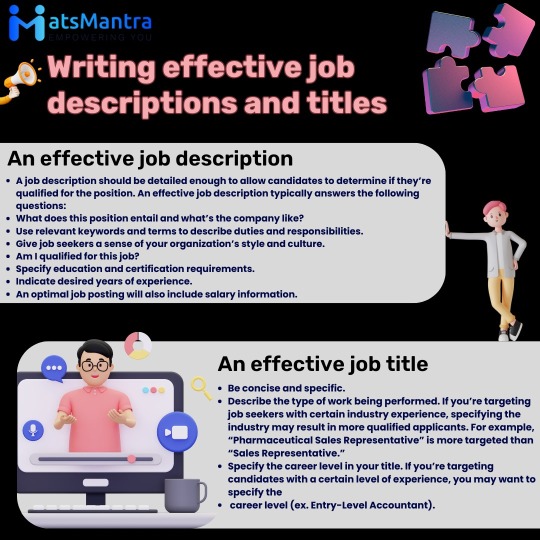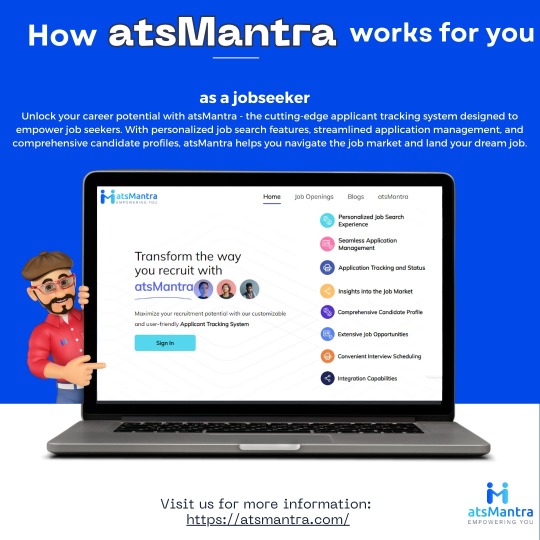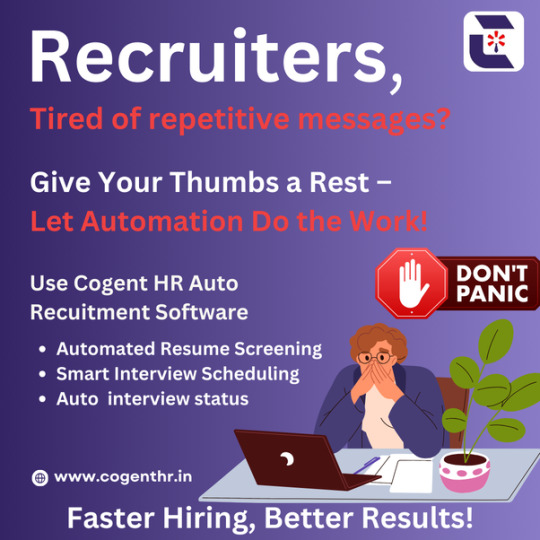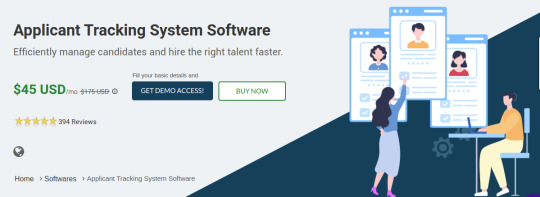#Applicant Tracking System (ATS)
Explore tagged Tumblr posts
Text
Why should I use an ATS in recruiting?
As the previous scenario illustrates, using a streamlined ATS in recruiting delivers many benefits:
It saves time. Not only does an ATS make your applicant pool easily accessible in an organised, searchable database, it also includes features that automate manual tasks. This frees recruiters to spend more time on high-value activities, like personalised outreach and relationship-building.
It helps you recruit more effectively. Collaborating and communicating with your talent organisation is easier with a centralised applicant tracking system. Robust analytics show your hiring team which sources are most fruitful, how long applicants take to move through the pipeline and other insightful metrics that can make your recruiting process even more effective.
It improves the candidate experience. An ATS allows you to stay on top of each applicant’s position in the recruitment process. This tracking minimizes the “black hole” — when candidates do not hear back from employers. CRM tools, a key component of your ATS, help recruiters follow up promptly and build relationships with clients.

3 notes
·
View notes
Text
What is an Applicant Tracking System?
An Applicant Tracking System is a software application companies can use to structure and customize their hiring into an efficient and scalable process. An ATS allows recruiters and hiring managers to attract, source, evaluate, and hire candidates better and faster.
What is the primary purpose of an Applicant Tracking System?
The primary goal of an Applicant Tracking System is to simplify the recruitment process and to make it more effective and efficient. This is accomplished by giving recruiters access to a powerful, centralized platform to collect and view applicants, track their progress, and filter them out based on their qualifications.
Generally, more powerful ATS platforms are cloud-based SaaS (Software as a Service) solutions, which you can access anywhere and anytime. The scope and complexity of specific ATS platforms and the cost will vary depending on what type of business it caters to. On-site and SaaS solutions will generally be more expensive but offer significantly more features and services than open-source options.
The three primary business types that an ATS serves are:
Enterprise-level companies
Recruitment agencies
Small or medium-sized businesses (SMBs)
2 notes
·
View notes
Text
A recruiter's complete guide to Applicant Tracking Systems
If you clicked on this article, it probably means you’re looking to learn about or better understand Applicant Tracking Systems (ATSs), or you’re in the market for one. Regardless of which it is, you’ve come to the right place. We’ve put together this guide to answer your burning questions about all things ATS and included insights from experts in the field.
Just a heads up, this is going to be a long (and good) read, so feel free to skip to the most relevant parts for you using our table of contents sidebar.
What is an Applicant Tracking System?
An Applicant Tracking System is a software application companies can use to structure and customize their hiring into an efficient and scalable process. An ATS allows recruiters and hiring managers to attract, source, evaluate, and hire candidates better and faster.
https://atsmantra.com

2 notes
·
View notes
Text
Tempted to become one of those LinkedIn influencers, but instead of telling overworked people to "work harder", I'm gonna challenge recruiters and CEOs into dropping their ATS scanners and actually go through every single applicant's CV and cover letter as a reading challenge.
Agree?
#LinkedIn#influencer#agree?#tedx talks#ATS#ATS scanner#applicant tracking system#make recruiting human again#recruiter#job recruiters#ai
4 notes
·
View notes
Text
How do AI-Powered Applicant Tracking Systems Help Build Stronger Talent Pools?
AI-powered Applicant Tracking Systems (ATS) transform recruitment by centralizing candidate data, automating engagement, and leveraging AI to keep a pipeline of qualified prospects ready for new roles. By treating candidates as long-term assets rather than one-off applicants, ATS enables recruiters to fill positions faster, reduce sourcing costs, and improve hire quality. In this article, we’ll explore:
What a talent pool is and why it matters
Five ways ATS builds and maintains talent pools
Additional ATS features that enhance pipeline strength
Real-world statistics and case examples
Best practices for maximizing ATS-driven talent pools
What Is a Talent Pool and Why Does It Matter
A talent pool is a categorized group of potential candidates—active and passive—who have demonstrated interest or match your organization’s hiring criteria. Rather than starting sourcing from scratch for each vacancy, recruiters tap into this pre-qualified database to accelerate hiring and reduce costs. Talent pools often include:
Active applicants who applied for previous roles
Passive candidates identified via sourcing tools
Alumni and past employees
Referrals and networking contacts
Strong talent pools lead to faster time-to-fill, lower acquisition costs, and better cultural fits by enabling continuous engagement and data-driven selection.
1. Centralized Candidate Database
ATS automatically ingests resumes and application data from career sites, job boards, email, and referral sources into a single, searchable database. This centralization:
Eliminates data silos—no more spreadsheets scattered across teams.
Enables keyword and skills searches across all historical applicants.
Surfaces “silver medalists”—candidates who narrowly missed previous roles yet remain strong fits.
With all candidate records in one place, recruiters can quickly mine past applicants before launching new sourcing campaigns, reducing redundant efforts by up to 30%.
2. Automated Candidate Engagement
Maintaining candidate interest over time is critical to keeping talent pools warm. AI-powered ATS includes email automation, SMS alerts, and chatbot interfaces to:
Send personalized job alerts when new positions match a candidate’s profile.
Trigger drip campaigns—e.g., newsletter invitations, company updates—to nurture passive prospects.
Provide real-time status updates on applications to enhance the candidate experience.
Automated engagement workflows ensure timely communication at scale, boosting re-engagement rates by as much as 45% compared to one-off outreach.
3. CRM-Style Nurturing and Segmentation
Top ATS platforms function like candidate relationship management (CRM) systems, offering:
Segmentation: Tag and group candidates by skill sets, locations, or roles.
Drip campaigns: Tailor outreach—webinars for engineers, events for sales pros.
Event tracking: Monitor candidate interactions (email opens, link clicks) to gauge interest.
This CRM-style approach treats talent pools as ongoing communities, not one-time transactions. By segmenting and delivering targeted content, recruiters deepen relationships, driving a 25% increase in engagement over generic mass emails.
4. AI-Driven Matching & Predictive Analytics
Advanced ATS leverages machine learning to analyze historical hiring data and score pool candidates based on:
Skills and experience match the new job requisitions
Likelihood to succeed, learned from past performance metrics
Cultural alignment, inferred from language patterns and assessments
Predictive analytics forecast future hiring needs—e.g., seasonal spikes in customer-support hiring—so recruiters can proactively expand relevant segments. AI-powered matching surfaces top prospects instantly, cutting screening time by up to 70%.
5. Data-Driven Pipeline Health Monitoring
Integrated dashboards in ATS provide real-time visibility into talent-pool metrics, such as:
Pipeline volume: Number of candidates per role or segment
Conversion rates: From pool to interview, interview to offer
Source effectiveness: Which channels contributed to the top-performing candidates
By tracking these KPIs, recruiting teams identify bottlenecks (e.g., low conversion in the “engineers” pool) and adjust tactics—launching targeted campaigns or refining sourcing filters—to maintain a healthy pipeline.
Additional ATS Features to Strengthen Talent Pools
Career-Site Integration
Embedding ATS job feeds and application forms on your career site ensures that every applicant enters the talent-pool database seamlessly, reducing drop-off from external redirects.
Job Distribution Automation
Automated multi-board postings—from LinkedIn to niche forums—keep talent pools fresh by attracting both active and passive candidates without manual posting work.
Assessment & Video-Interview Integrations
Linking assessment platforms and one-way video tools enriches candidate profiles with performance data, enabling recruiters to nurture only high-potential prospects in critical skill areas.
Background Check Workflows
Automated triggering of background and reference checks when candidates meet pool criteria ensures compliance and speeds time-to-hire for pre-screened talent.
Real-World Impact & Statistics
50% faster sourcing: Companies using ATS-driven talent pools report halving their time-to-fill for repeat roles.
20–30% lower acquisition costs: Reusing pre-qualified pool candidates reduces reliance on expensive external agencies.
15% higher quality-of-hire: AI-matched candidates from talent pools consistently outperform cold-sourced applicants.
45% increased candidate engagement: Automated nurturing drives stronger response rates compared to ad hoc outreach.
Best Practices for ATS-Driven Talent Pools
Define Clear Segments Establish pool categories by role, skill, or geography to focus nurturing efforts and content.
Automate Smart WorkflowsUse trigger-based campaigns (e.g., event follow-ups) to keep engagement high without manual effort.
Maintain Data Hygiene Regularly archive inactive profiles and solicit updates from stale contacts to keep pool data current and GDPR-compliant.
Combine AI with Human Touch Leverage AI for screening, but personalize final outreach and interviews to assess soft skills and cultural fit.
Monitor & Iterate Review pipeline health dashboards monthly, adjusting segments, messaging, and sourcing channels based on performance.
Conclusion
Applicant Tracking Systems do far more than process one-off applications—they empower recruiters to build, nurture, and leverage strategic talent pools. By centralizing candidate data, automating engagement, applying CRM principles, and harnessing AI for predictive matching, organizations can:
Fill roles faster
Reduce sourcing costs
Strengthen the employer brand
Improve the quality of hires
Implementing best practices around segmentation, automation, and data governance ensures your AI-powered ATS-driven talent pools become a sustainable competitive advantage in today’s talent-driven market.
#applicant tracking system for small business#ats hr software#corporate learning management systems#applicant tracking systems ats#ats tracking system#ats software solutions#best applicant tracking systems#top applicant tracking software#ats software#best ats systems
0 notes
Text
5 Characteristics of an ATS Friendly Resume (And How to Nail It)
When people hear “ATS,” it often sounds like a mysterious gatekeeper. But here’s the truth: ATS isn’t a single system or a universal algorithm. Applicant Tracking Systems are built and configured by different vendors, customized heavily by employers, and used in surprisingly different ways depending on the industry, company size, and hiring needs. First, Let’s Set the Record Straight There’s no…
#Ai Resume Builder#Applicant Tracking System#Ats Friendly Resume#Ats Resume#Generate Resume#Job Application Tips#job search advice#Resume Analyzer#Resume Keywords#Resume Tips
0 notes
Text
🚨 Recruiters, You’re Wasting 60% of Your Time Without This Tool 🚨
Struggling with ghosted candidates, messy spreadsheets, or never-ending interview rounds? You’re not alone — and you’re not efficient.
💡 What if we told you the top Fortune 500 companies already use a tool that automates hiring, boosts candidate engagement, and slashes hiring time in half?
😱 The truth? Companies using this system report: ✅ 78% better hire quality ✅ 86% faster time-to-hire ✅ 3x lower cost-per-hire
👀 Wondering what it is? 👉 Read the full breakdown on how to master ATS campaigns now
You’ll learn how to: 🔹 Launch high-performing ATS campaigns 🔹 Fix broken workflows 🔹 Track and hire like a Fortune 500 pro
📉 Still doing hiring the old-fashioned way? You’re already falling behind.
💥 Click here to level up your recruitment process now
#Applicant Tracking System#ATS#Hiring#Recruitment#HR Tech#Talent Acquisition#Hiring Strategy#Candidate Experience#HR Tools#Hiring Process#oorwin#TalentIntelligence
0 notes
Text
Applicant Tracking System Pricing & Cost Comparison: How to Choose the Best ATS for Your Budget
Introduction
An Applicant Tracking System (ATS) is a crucial tool for modern recruitment, helping businesses streamline hiring processes. However, Applicant tracking system pricing based on features, company size, and deployment options. Understanding these costs and comparing ATS providers is essential for making a cost-effective decision.
This article breaks down ATS pricing models, compares popular ATS solutions, and highlights key cost factors to help businesses find the best system for their needs.
ATS Pricing Models
Different ATS providers use various pricing structures to cater to businesses of all sizes. The most common pricing models include:
1. Per User Pricing
Cost is based on the number of recruiters or hiring managers using the ATS.
Best for: Mid-to-large companies with multiple HR professionals.
Example: Greenhouse, Lever ($100–$150 per user/month).
2. Per Job Posting Pricing
Charges depend on the number of active job postings.
Best for: Small businesses and startups with occasional hiring needs.
Example: Workable ($99 per job/month).
3. Flat Monthly Subscription
A fixed monthly fee regardless of job postings or users.
Best for: Companies with consistent hiring activity.
Example: JazzHR (Starts at $39/month).
4. Per Employee Pricing
Cost is based on the total number of employees in the company.
Best for: Businesses integrating ATS with HR software.
Example: BambooHR ($6–$12 per employee/month).
5. Custom Enterprise Pricing
Tailored pricing for large enterprises with advanced hiring needs.
Includes: AI-powered automation, integrations, and premium support.
Example: iCIMS, SAP SuccessFactors (Custom pricing available).
Factors Affecting ATS Pricing
1. Business Size & Hiring Volume
Small businesses: Benefit from per-job or flat-rate ATS models.
Mid-to-large companies: Prefer per-user pricing.
Enterprises: Require custom AI-driven solutions.
2. Features & Customization
Basic ATS: Job posting, resume tracking, and candidate communication.
Advanced ATS: AI-powered screening, analytics, and automation tools.
3. Integrations & Add-Ons
Costs increase with background checks, job board posting, and CRM integrations.
4. Deployment Type (Cloud vs. On-Premise)
Cloud-based ATS (SaaS): Subscription-based, lower upfront costs.
On-premise ATS: One-time licensing fee but higher maintenance costs.
5. Customer Support & Implementation Fees
Some ATS vendors charge extra for premium support, training, and onboarding.
Key Factors Influencing ATS Pricing
Several factors impact the cost of an ats pricing comparison, including:
Number of Users: Larger teams require higher-tier pricing plans.
Recruitment Volume: High-volume hiring necessitates more robust features and integrations.
Integration Needs: ATS solutions that integrate with HR software, job boards, and assessment tools may incur additional fees.
Customization and Support: Custom workflows, dedicated support, and API access often contribute to premium pricing.
Conclusion
ATS pricing varies based on company size, hiring volume, and feature requirements. While small businesses may benefit from pay-per-job ATS models, large enterprises require custom AI-powered solutions.
Businesses can invest in the right ATS to optimize their hiring process while staying within budget by comparing pricing models, features, and additional costs.
Related Articles:
Understanding Applicant Tracking System Pricing: Key Insights for Recruiters
Applicant Tracking System Costs: Breaking Down Pricing Structures
Balancing Cost and Features: Finding the Perfect ATS for Your Business
0 notes
Text
Hiring strategies that don’t require calling candidates
In today’s fast-paced, digitally driven world, traditional recruitment methods like phone calls are becoming increasingly outdated.
While phone calls were once the cornerstone of candidate communication, they are now often seen as time-consuming, inefficient, and inconvenient for both recruiters and candidates. we’ll dive into the tools and techniques that are transforming recruitment into a seamless, candidate-friendly experience.
Why Avoiding Phone Calls Can Improve Recruitment
Saves Recruiters’ Time and Effort
Phone calls are inherently time-consuming. Scheduling calls, waiting for candidates to respond, and manually taking notes can eat up hours of a recruiter’s day. By adopting alternative communication methods, recruiters can automate repetitive tasks, focus on high-value activities, and significantly reduce the time-to-hire.
more…
Effective Hiring Strategies Without Phone Calls
1. Auto Resume Screening
Auto-driven tools can analyze resumes and applications in seconds, identifying the most qualified candidates based on predefined criteria. This eliminates the need for manual screening and ensures that recruiters focus only on top-tier talent.
more…

#ats#human resources#applicant tracking software#hiring and recruiting#applicant tracking system#hr#recruiting solutions
1 note
·
View note
Text
ATS-Friendly Resumes: Secrets to Beating the Bots (and Landing That Interview!)
So, you’ve spent hours crafting the perfect resume. It’s got personality, flair, and maybe even a little sparkle. You send it off into the job application abyss, only to hear…nothing. Silence. Crickets. What happened?! Well, my friend, you may have just been ghosted by a bot. Meet Your New Gatekeeper: The ATS Before your resume even reaches human eyes, it must pass through an Applicant Tracking…

View On WordPress
#Applicant Tracking System#ATS Resume Tips#ATS-friendly resume#Beat The Bots#career advice#Career Growth#career success#get hired#hiring process#job application tips#Job Hunting#job interview tips#job search strategies#job search tips#Landing an Interview#Optimized Resume#professional resume#Resume Best Practices#Resume Checklist#Resume for ATS#resume formatting#resume keywords#Resume Optimization#resume writing#Winning Resume
0 notes
Text
How to Use ATS Systems to Get Noticed by Recruiters
Applicant Tracking Systems (ATS) have revolutionized the hiring process, making it easier for recruiters to filter through thousands of applications efficiently. If you want to increase your chances of getting noticed, understanding how ATS works and optimizing your resume accordingly is essential.
What is an ATS?
An ATS is a software application that automates the hiring process by scanning resumes, filtering candidates, and ranking them based on relevance to job descriptions. Recruiters use these systems to streamline hiring, making it crucial for job seekers to ensure their resumes align with ATS requirements.
For those looking to maximize their job search efforts, platforms like Find Jobs Online provide numerous opportunities to discover new openings and connect with recruiters.
Key Strategies to Optimize Your Resume for ATS
1. Use Relevant Keywords
ATS relies on keywords to assess the suitability of candidates. Ensure your resume includes industry-specific terms found in the job description, such as programming languages, certifications, or key responsibilities.
2. Maintain a Simple and Clean Format
Avoid complex layouts, graphics, and unusual fonts, as ATS systems may struggle to parse these elements. Stick to standard fonts like Arial or Times New Roman and use clear headings and bullet points.
3. Customize Your Resume for Each Job Application
A one-size-fits-all resume may not always work. Tailor your resume for each application by incorporating relevant keywords and focusing on skills and experiences that match the job posting.
4. Optimize Your Resume with Proper Headings
Use standard section headings like "Work Experience," "Education," and "Skills." This helps ATS easily navigate and categorize your resume correctly.
5. Avoid Unnecessary Information
Including irrelevant details like personal photos, fancy designs, or excessive personal information can reduce the ATS-friendliness of your resume. Stick to essential details that showcase your professional qualifications.
How to Improve Your Chances of Getting Noticed by Recruiters
1. Build a Strong Online Presence
Having a LinkedIn profile that complements your resume can boost your visibility. Recruiters often cross-check online profiles to validate the information provided in resumes.
2. Network with Industry Professionals
Engaging in networking events, joining professional groups, and connecting with recruiters on job portals can improve your chances of landing an interview.
3. Keep Your Resume Updated
Regularly updating your resume ensures that your latest achievements, skills, and experiences are included, making you a more attractive candidate to potential employers.
Common Mistakes to Avoid When Using ATS Systems
Overstuffing keywords in a way that disrupts readability.
Using images, charts, or tables that ATS may not interpret correctly.
Submitting resumes in non-standard formats like JPEG or PNG instead of PDF or DOCX.
Ignoring job description requirements when tailoring your resume.
Conclusion
Getting noticed by recruiters requires a strategic approach to resume optimization and job searching. By leveraging ATS best practices, utilizing job search platforms like ATSMantra, and continuously refining your skills, you can significantly increase your chances of landing your desired job. Stay proactive, network with professionals, and ensure your resume is ATS-friendly for the best results.
1 note
·
View note
Text
Why Every Business Needs an Applicant Tracking System for Smarter Hiring

Hiring the right talent is crucial for any business, but the traditional recruitment process can be overwhelming. Sorting through resumes, keeping track of applications, scheduling interviews, and ensuring smooth communication between recruiters and candidates takes a lot of time and effort. If your hiring team is struggling with these challenges, it’s time to consider an applicant tracking system.
An ATS helps businesses automate and optimize their hiring process, ensuring that they find and hire the best candidates quickly and efficiently. Let’s explore why investing in applicant tracking software for recruiters is essential in today’s competitive job market.
What is an Applicant Tracking System (ATS Software)?
An applicant tracking system is a software tool that helps businesses manage the entire hiring process in one place. From posting job openings and screening resumes to scheduling interviews and tracking candidates’ progress, an ATS software simplifies and speeds up recruitment.
Many companies, including small businesses and large enterprises, use the best applicant tracking software to streamline hiring and make data-driven decisions. The system allows recruiters to automate repetitive tasks, improve collaboration, and ensure a smooth hiring experience for both HR teams and candidates.
How Does an Application Tracking System Help Recruiters?
An applicant tracking software for recruiters is designed to address the most common hiring challenges. Here’s how it benefits businesses:
Saves Time and Reduces Manual Work
Without an ATS, recruiters spend hours reviewing resumes, organizing applications, and manually updating spreadsheets. An ATS software automates these processes, saving valuable time and allowing HR teams to focus on engaging with the best candidates.
Improves Hiring Accuracy with Smart Filtering
One of the biggest challenges in hiring is filtering through hundreds of resumes to find qualified candidates. The best applicant tracking software comes with intelligent filtering features that automatically screen resumes based on predefined criteria, such as skills, experience, and qualifications.
Enhances Candidate Tracking and Communication
Keeping track of each candidate’s status can be difficult, especially for businesses handling multiple job openings. An applicant tracking system provides a centralized dashboard where recruiters can monitor applications, send automated emails, and manage interview scheduling seamlessly.
Boosts Collaboration Among HR Teams
Hiring isn’t just about recruiters—it involves HR managers, department heads, and sometimes even CEOs. An ATS software allows teams to collaborate by sharing candidate evaluations, leaving feedback, and making hiring decisions more efficiently.
Reduces Hiring Costs and Improves ROI
A slow or inefficient hiring process can be expensive. Companies that use applicant tracking software for recruiters report reduced hiring costs because they spend less time on administrative work and more time hiring the right people. Faster hiring also means fewer lost opportunities.
Why Choose the Best Applicant Tracking Software for Your Business?
With so many options available, choosing the best applicant tracking software can make a significant difference in your hiring success. Here are some key features to look for:
Automated Resume Screening – AI-powered filtering to shortlist the best candidates
Job Posting Management – Easy posting across multiple job boards
Customizable Recruitment Workflow – Tailor the hiring process to your company’s needs
Interview Scheduling – Integrated tools for hassle-free scheduling
Reporting and Analytics – Data-driven insights for better hiring decisions
When you invest in a high-quality application tracking system, you not only improve efficiency but also create a positive hiring experience for candidates.
Recommended Read: HRMS Solutions: 7 Ways To Help Your Business Grow In 2025
Final Words
The hiring process is evolving, and companies that rely on outdated recruitment methods may struggle to attract top talent. A modern applicant tracking system ensures that businesses can streamline recruitment, improve accuracy, and make better hiring decisions.
Whether you’re a small business or a growing enterprise, implementing applicant tracking software can transform the way you hire. With Logicspice’s ATS software, you can automate time-consuming tasks, improve team collaboration, and hire the best talent faster.
Looking for the best applicant tracking software? Discover how Logicspice can help you simplify your hiring process!
#application tracking system#applicant tracking system#ats tracking system#ats software#applicant tracking software#best applicant tracking software#applicant tracking software for recruiters
0 notes
Text
Adopting the best applicant tracking systems integrated with generative AI offers recruiters a significant advantage in staying ahead. Embrace this transformation to build a future-ready recruitment strategy that attracts and retains top talent.
0 notes
Text
Simplify Hiring with AblyWorks – The Best Applicant Tracking System for Growing Teams

In today’s fast-paced business environment, finding the right talent quickly and efficiently is crucial. Manual processes, cluttered inboxes, and disorganized workflows can slow down hiring and cost you top candidates. That’s where AblyWorks, a powerful and intuitive applicant tracking system, comes in.
AblyWorks is built to simplify recruitment, improve collaboration, and ensure you never miss out on the perfect hire.
What Is AblyWorks?
AblyWorks is a cloud-based applicant tracking system software that helps organizations manage their entire hiring process in one place. From job postings to candidate onboarding, it automates routine tasks and provides visibility at every step.
Whether you're a startup or a large enterprise, AblyWorks makes your recruitment process faster, smarter, and more effective.
Why Choose AblyWorks?
When looking for the best applicant tracking system, it’s not just about features—it’s about results. AblyWorks delivers:
✅ Centralized Candidate Tracking
Say goodbye to spreadsheets and email threads. Manage all applications, interviews, and feedback in one unified dashboard.
✅ Resume Screening Automation
Save hours with AI-powered resume parsing and ranking, helping you focus only on top-quality candidates.
✅ Seamless Job Board Integration
Post job openings across LinkedIn, Naukri, Indeed, and other platforms in just a few clicks.
✅ Customizable Hiring Workflows
Tailor each step of your hiring process to suit different roles, departments, or teams.
✅ Real-Time Analytics
Track key metrics like time-to-hire, source performance, and recruiter activity to make data-driven decisions.
A Trusted Applicant Tracking System Provider
What sets AblyWorks apart is not just its features, but its commitment to being a reliable and supportive applicant tracking system provider. With personalized onboarding, ongoing support, and a user-first approach, AblyWorks ensures your hiring runs smoothly—today and as you scale.
Final Thoughts
If your team is still juggling resumes and interview notes across multiple platforms, it’s time for a change. Investing in the right technology can transform your recruitment efforts. As one of the best applicant tracking systems on the market, AblyWorks empowers you to hire faster, better, and with greater confidence.
Experience the future of recruitment with AblyWorks—your complete solution for streamlined hiring.
0 notes
Text
#resume screening software#best applicant tracking system software#top rated applicant tracking systems#applicant tracking systems for small companies#ats software#ats software solutions#best ats software#best applicant tracking systems for small businesses#applicant tracking system for small business#ats tools for recruitment#ats tracking system#top applicant tracking software#applicant tracking software for recruiters#applicant tracking systems list#popular ats systems
0 notes
Text
0 notes